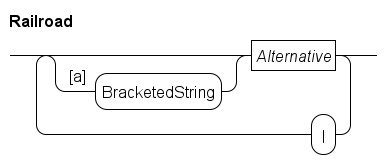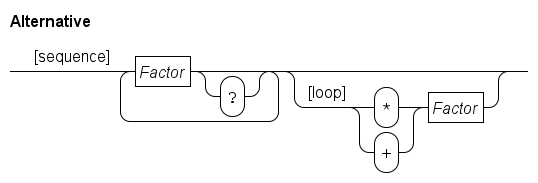Grammar
The toplevel grammar rule of the application is Specification. It is a sequence of rules, each terminated by a semicolon. One specification creates one output file.

A Rule is a possibly named railroad.

A Railroad is one or more choice alternatives.

The BracketedString like [a] can be used to denote specific points in the diagram allowing you to refer to such points from the explanatory text.
An Alternative has a sequence of one or more factors. The optional ? character makes a factor optional. By appending the [loop] part, the sequence can be repeated. The + requires at least one sequence, the * also allows 0 repetitions, resulting in an empty sequence. The second Factor defines the syntax on the way back to the start. Note that parentheses are required in the second Factor if is it more than one node.

Note that together with | above and the empty sequence () below, you can write all loops using the + infix operator. The Examples section explains this as well.
In an alternative, Factor is a single token:

The [literal1] and [literal2] choices show the text of the string. Surrounding quotes are dropped. There are two forms of literals to simplify using single or double quote literals in the diagrams. The [sub-diagram] choice allows nesting of sequence, choice, and repetition, enabling construction of more complicated diagrams. The [epsilon] choice is the empty sequence. The [sub-rule] choice enables giving the name of another diagram to process.
Finally, the [line-break] choice can be used to split a long sequence of factors into multiple rows. In general, its use should be avoided as it often leads to less pretty diagrams. Instead, try to re-organize rules or diagrams.